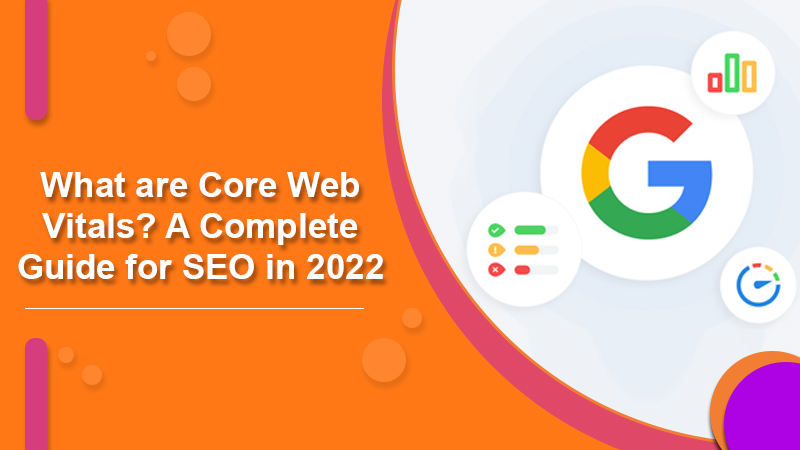On the 28th of May, 2020, Google introduced Core Web Vitals. They are a set of standardized metrics that help developers use to measure user experience. Although these metrics were created to help developers, website owners can use them too as they break down the user’s real-world design on a page.
Core Web Vitals condense the user’s experience into the following primary areas:
- Page loading performance
- Ease of interaction
These elements are essential to understanding how users interact and engage with a website. Developers need these metrics to improvise the UX of a website. At the same time, website owners use the same to identify and fix technical imparities across their websites. However, these metrics are not the only ones that define the user experience in website SEO services.
What are the three main Core Web Vitals metrics?
- Largest Contentful Paint(LCP)
Largest Contentful Paint is a Core Web Vital metric that site owners can use to assess user experience. The user can find the page helpful depending on the render time of the most significant blocks visible to an audience. Pages on the internet need to load faster for an enjoyable user experience.
The loading time of a page betters the user experience and enables the site to rank higher on Google. Therefore, site owners should typically aim for an LCP of 2.5 seconds for the page to load. The page loading speed can directly impact engagement, conversion rates, and other SEO services.
- Cumulative Layout Shift(CLS)
A website’s links and buttons should be engaging enough to drive sales and convert clicks. The Cumulative Layout Shift(CLS) metric identifies links or buttons that change places after loading a page. It tells you the difficulty level users will face while trying to interact with the elements on the rendered page of your website.
Since shifting elements on a webpage can frustrate users, developers use CLS to determine if the same can improve usability, click-through rates, and online sales. Site owners should maintain a CLS of 0.1 or less. CLS uses the core metrics to assess the visual stability of the page to a user through the following factors:
- Layout shift
- Impact fraction
- Distance fraction
- First Input Delay(FID)
The First Input Delay metric measures input latency, or the time it takes for a page element to respond to a user’s input. FID records click and key presses and identify those pages that can cause trouble to the user. Even though the content gets delivered in an enhanced form, it may make the person wait for further actions on their inputs.
Developers aim to reduce the time for input latency so that the engagement and site usability remains unaffected. A good user experience with an FID below 100 milliseconds is ideal. The overall score of FID depends on variables outside your control, such as users’ device capability and the internet speeds of the audience.
How to optimize a website for Core Web Vitals?
These six common elements reduce page speed and Insight Scores. The following elements, if worked on, can help in optimizing your website’s SEO services for Core Web Vitals:
- Image formats and sizes
Images like the one at the top of the page, in-line, and background images can be the biggest culprits for a low insight score. In the following techniques, you can get the images optimized:
- Compress the images
- Use the correct size and dimensions
- Implement lazy loading
- Set height and width attributes to image tags
- Videos
You can use a third-party video hosting service like YouTube or Vimeo to present your videos to your visitors. This will reduce the bandwidth on your server while delivering the correct video quality to the visitor. In addition, by deferring the rendering of your video, you can take some time off the initial page load.
- Tracking scripts
It is better not to use third-party tracking scripts irrelevant to your business or its marketing. Instead, use the Google tag manager to review the tags and scripts on your website.
- Fonts
Stick to the norm of having eight custom font variants on your website. This includes the font families, font weights, and the italic versions of the font. The preloaded font assets will improve the page loading time. Additionally, storing the fonts will reduce the number of HTTP requests and DNS lookups.
- Ads, banners, and Pop-ups
Any change in the layout that happens without the user’s input will cause an unexpected change. This will produce a bad CLS score and, most importantly, annoy the user. The solution would be to check for the dimensions and the space allocated to the ad/banner so that the page layout doesn’t shift. It is also preferable not to have the ad/banner content overlapping the other content on the webpage.
- CSS and JavaScript
You can optimize CSS and JavaScript by minifying and combining. Furthermore, you can turn off CSS and JavaScript calls for pages that don’t require them or defer them to when needed.
In conclusion
Core Web Vitals are three metrics that measure and improve the user experience on your web pages. The better the UX is, the better the page score, the ranking, and the quality of SEO services. These metrics have simplified analyzing website issues and focus on those areas where updates are needed.

